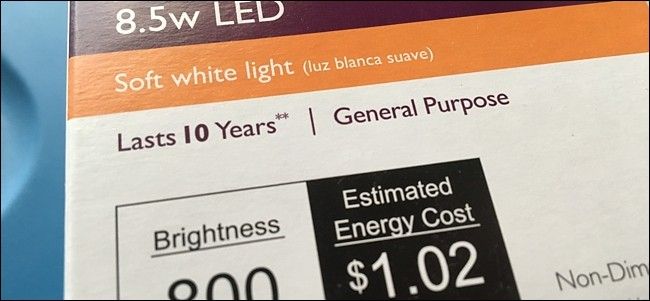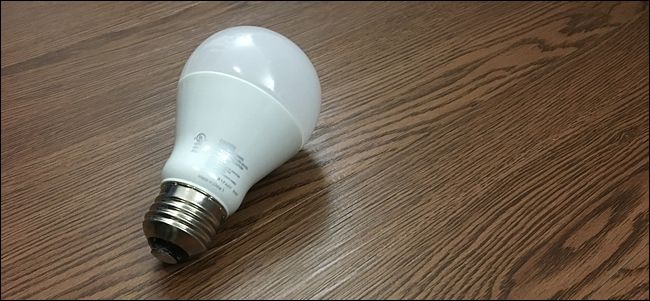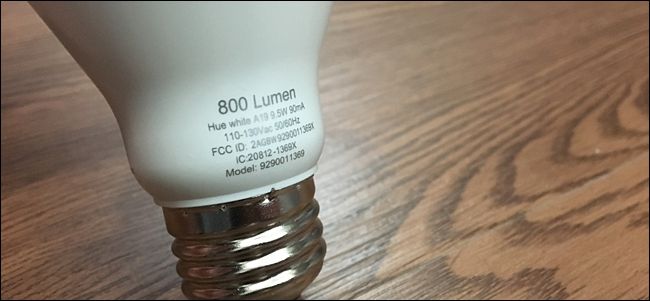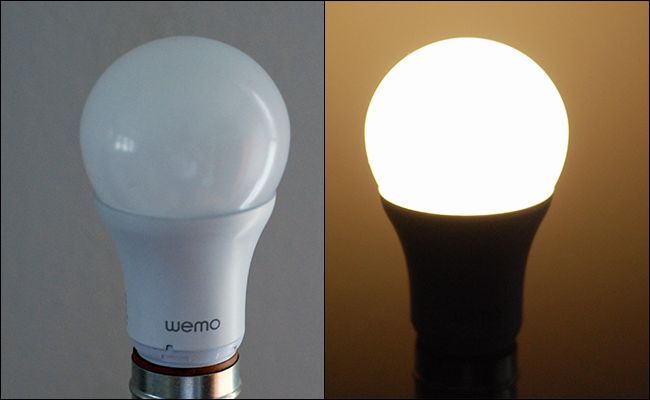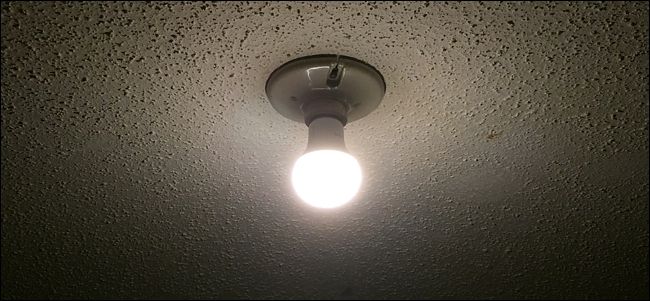Quick Links
LED bulbs are bit a more expensive than other types of light bulbs, but they claim to last a lot longer. But do LED bulbs actually last the 10 years that many manufacturers claim?
The 10-Year Lifespan Assumes a Lot About Your Usage
Even the cheapest LED light bulbs (Philips sells some for as low as $2 per bulb) claim to have a 10-year lifespan, but it's important to know that's actually based on some pretty modest assumptions. If you read the fine print (notice the asterisks next to the 10-year claim in the image above), a 10-year lifespan is based on only having the bulb on for three hours per day, every day. In some households, this can be accurate, but in others, that's laughable.
This particular 10-year claim means that the bulb can last for nearly 11,000 hours. So if we were to have the bulb on for eight hours every day (two hours in the morning and six hours in the evening, for instance---possibly longer on the weekends), this means that it would only last shy of three and a half years.
Compared to an incandescent light bulb that has an average 1,000-hour lifespan, 11,000 hours is still way better, but don't let the 10-year claims fool you. Plus, there are plenty of other factors to keep in mind.
LED Bulb Circuits Are the Biggest Problem
If you take a look at the circuitry of an incandescent bulb, you'll notice that it's pretty simple: There are two contact wires connected together by a filament. Power comes through one of the contact wires, lights up the filament, and exits out of the other contact wire. Simple right? After all, it's technology that's been around since the 1800s.
However, if you peek inside an LED bulb, it's much more complex. You'll find a handful of resistors, capacitors, and inductors on top of the several LEDs that actually provide the light.
It's true that LEDs (short for Light-Emitting Diode) can last a very long time, but the circuitry inside of an LED bulb is way more complex than anything ever seen in a light bulb before--- especially with dimmable LED bulbs, which require even more circuitry. And with more circuits comes the greater likelihood that something will fail. Put another way: The weakest link is the circuitry, not the LEDs themselves.
So if you notice that your LED light bulbs are burning up well before the 10,000-hour mark, it's likely that the bulb didn't actually reach the end of its natural life, but rather the complexity of the circuit got the best of itself in some way.
LED Bulbs Degrade Over Time
One big difference between LED bulbs and incandescent bulbs is that LED bulbs don't just burn up and stop working once they reach the end of their lifespan. Instead, they slowly degrade, their maximum brightness getting lower and lower over time.
When LED bulb manufacturers come up with the number of hours that an LED bulb can last, that number actually includes a little bit of time where the bulb is slowly degrading.
The cut-off point is 70% of the bulb's full potential brightness. So if an LED bulb can emit 800 lumens and it slowly degrades to only emitting 570 lumens, that's still within the time frame of an LED bulb working within its 10,000-hour lifespan. It's only when it gets below 70% of its full brightness that manufacturers deem a bulb to be unfit for providing enough light.
Heat Can Limit a Bulb's Lifespan Even Further
Electronics produce heat, which is why you see heatsinks and fans in computers and other electronics. However, when that heat gets too out of control, it can degrade the life of the electronics and even cause it to fail.
LED bulbs are the same way. However, it's not the LEDs that get hot, but rather the circuitry underneath. It's all squished into a small space, and when that happens it can produce a lot of heat. The bulb's base is often designed act as a heatsink of sorts so it can dissipate that heat.
But when you stick an LED bulb inside of an enclosed fixture, the heat has nowhere to escape and the bulb can overheat, leading to a quicker failure.
Take Care of Your Bulbs and They'll Take Care of You
LED bulbs haven't really been around long enough to properly test the 25,000-hour lifespan in a real-world scenario. Even if you left the bulb on 24/7, it would still take almost three years for it to reach its natural death.
However, there are things you can do to make sure that your bulbs last as long as possible, barring any unexpected failures from a faulty bulb. As mentioned before, excessive heat is the enemy, so keeps LED bulbs out of enclosed fixtures that aren't meant for LED bulbs.
Furthermore, don't mix bulb types in a multi-bulb light fixture. Incandescent and other types of bulbs can generate more heat than an LED bulb, and that heat can make it's way over to the LED bulb, making it run hotter than it already is.
Also, turn your lights off when you're not using them. It's easy to overlook this when you know LED bulbs hardly use any electricity, but you're still spending money (however much) to keep lights on for no reason. Plus, the longer you leave light bulbs on, the more you're chewing into the bulb's remaining lifespan, further shortening its life.

